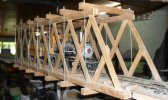Fred Seider
Registered
Hi everyone. I am looking for some info on the general diameter of mid to late 1800's (though not critical at all) timber truss bridge tension rod diameters. The wood dimensions are easy enough to get, but those tension rods I can't seem to locate. If it's all over the map, which I suspect, be good to hear what a typical min/max was in actual inches/mm.
Thanks in advance
Fred
Thanks in advance
Fred

